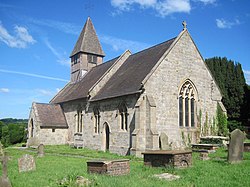Buildwas
| Buildwas | |
| Shropshire | |
|---|---|
 Buildwas Church | |
| Location | |
| Grid reference: | SJ641045 |
| Location: | 52°38’13"N, 2°31’52"W |
| Data | |
| Population: | 321 (2011[1]) |
| Post town: | Telford |
| Postcode: | TF8 |
| Dialling code: | 01952 |
| Local Government | |
| Council: | Shropshire |
| Parliamentary constituency: |
Shrewsbury and Atcham |
Buildwas is a village and parish in Shropshire, on the north bank of the River Severn. It lies on the B4380 road to Atcham.
Buildwas has a nine-hole golf course which runs between the River Severn and Ironbridge Power Station. It is open to members of Buildwas Abbey Club.
Contents
History
The village of Buildwas has been recognised since 1086 as the first reference to it was made in the Domesday Book. Buildwas was valued at £2.30 to the Lord St John Bishop of Chester in 1086. The land was valued at £2.30 due to the fact that the village was located on the River Severn and had woodland which was useful for agricultural and farming purposes. During this time period the village had a total population of nine households with them being divided into three for villagers, five for slaves and one for reeves. Due to this the village only had a total tax assessment of one geld unit which was very small. Buildwas had resources of 200 pigs and a mill which people relied on.[2]
Buildwas Abbey
The preserved remains of a Cistercian abbey lie on the south bank of the River Severn. These include an unusually unaltered 12th-century church, a vaulted and tile-floored chapter house, and a re-opened crypt chapel.[3] The abbey was built in 1135 and the main income for the abbey came from tolls charged on the adjacent bridge over the river. The site is now cared for by English Heritage.[4]
Bridge
A brick and stone bridge crossed the Severn from mediæval times to the 18th century; in floods of 1773 and 1795, it was irreparably damaged and finally swept away by severe flooding following an earthquake.[5] After its destruction, Thomas Telford built an iron bridge, based on but lighter than The Iron Bridge, which survived subsequent floods intact until its replacement by steel lattice in 1905, which itself was replaced in 1992.[6]
References
| ("Wikimedia Commons" has material about Buildwas) |
- ↑ "Civil Parish population 2011". http://www.neighbourhood.statistics.gov.uk/dissemination/LeadKeyFigures.do?a=7&b=11121394&c=Buildwas&d=16&e=62&g=6460935&i=1001x1003x1032x1004&m=0&r=1&s=1448293203297&enc=1. Retrieved 23 November 2015.
- ↑ "Domesday Book". University of Hull. http://domesdaymap.co.uk/place/SJ6304/buildwas/. Retrieved 26 April 2012.
- ↑ "English Heritage". English Heritage. http://www.english-heritage.org.uk/daysout/properties/buildwas-abbey/. Retrieved 1 May 2012.
- ↑ "Visiting Buildwas". Beth Heath. http://buildwasvillage.com/Visiting-Buildwas. Retrieved 1 May 2012.
- ↑ "Buildwas Bridge and the Severn Earthquake of 1773". revolutionaryplayers.org.uk. http://www.revolutionaryplayers.org.uk/buildwas-bridge-and-the-severn-earthquake-of-1773/. Retrieved 2017-05-07.
- ↑ "Buildwas Bridge, site of". engineering timelines. http://www.engineering-timelines.com/scripts/engineeringItem.asp?id=1314. Retrieved 2017-05-07.